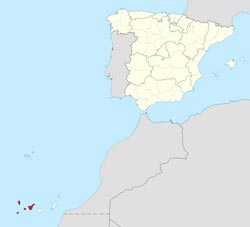Santa Cruz de Tenerife in Santa Cruz de Tenerife

The name is quite a mouthful, and that is probably why both the province and its capital are often referred to just as plain ‘Tenerife’.
It is one of the two provinces that make up the region of the Canary Islands. The name Tenerife also refers to the island where the capital is situated; the province consists of this and three more islands, La Palma, La Gomera and El Hierro, apart from some rock formations, all with their own names, in the surrounding sea. The province is home to 1,044,887 souls and, and the island of Tenerife is the most densely populated of the Canary Islands. It also has the highest percentual growth rate in the archipelago.
 Tenerife is Spain’s western and southernmost province, and it is home to the tallest peak in Spain: the Teide which reaches 3,718 meters into the sky, and measured from the bottom of the sea its full height is 7,500m. Teide is a volcano, and it is Earth’s fourth tallest volcanic structure. It is an active volcano and it last erupted in 1909. Surrounding Teide is an 18.9 hectare national park, Parque Nacional del Teide, which was named World Heritage Site by the UNESCO in 2007.
Tenerife is Spain’s western and southernmost province, and it is home to the tallest peak in Spain: the Teide which reaches 3,718 meters into the sky, and measured from the bottom of the sea its full height is 7,500m. Teide is a volcano, and it is Earth’s fourth tallest volcanic structure. It is an active volcano and it last erupted in 1909. Surrounding Teide is an 18.9 hectare national park, Parque Nacional del Teide, which was named World Heritage Site by the UNESCO in 2007.
The capital of Santa Cruz de Tenerife is Santa Cruz de Tenerife. It is situated on the north-eastern tip of the island of Tenerife, and it borders on the Atlantic Ocean on three sides. The city is nestled between the Bay of Santa Cruz de Tenerife and the Anaga massif. It covers 150.56 km2 and the height above sea level of Tenerife lies between 4 MASL in the historic centre and 1,020 MASL at the Cruz de Taborno, the highest point of the Anaga massif. The city boasts 58 km of coastline.
Tenerife is blessed with a very mild climate, and the average temperatures vary by no more than 7 to 8 degrees Celsius between the 18.3ºC of January and February, and the 25.5ºC in mid-August. In the past, the maximum temperatures in summer rarely went above 29ºC – the high average temperatures were caused by the calid nights which rarely saw minimum temperatures fall below 22ºC. However, in later years the summer temperatures often reach well into the thirties, and they reached as much as 42.6ºC a couple of years ago.
The winters are mild, and the minimum temperature ever registered in the city was 8.1ºC. The annual rainfall is in the region of 220-230 mm, the majority of which fall in autumn and winter. There are just under 30 rainy days a year, and the sun shines for some 2,912 hours every year. The climate combined with a wealth of wide, sandy beaches and mild sea temperatures all year round has turned Santa Cruz de Tenerife into a tourist paradise visit by millions of travellers every year, both tourists who are staying in other parts of the island and visit for the day, and those who choose to spend their entire holiday in the capital.
The annual carnival in Tenerife, Carnaval de Santa Cruz de Tenerife, followed by those of Cádiz and Águilas, is the most internationally famous and visited carnival in Spain, and it is considered second only to the carnival of Rio de Janeiro, with which city Santa Cruz de Tenerife is twinned for the same reason. It was declared ‘Fiesta de Interés Turístico Internacional’ by the Ministry of Tourism in 1980, and for a week in February every year the streets of Tenerife turn into one big fiesta, and the tourism figures are on par with those of July and August. Thanks to the tourism the economy of Tenerife is largely based on the tertiary sector, services. However, the city is also home to Spain’s oldest oil refinery, which is the largest industrial concern in the Canary Islands. The refinery’s localization within the city, however, is highly criticized by those that claim that the massive installations take up space that should be available for city expansion.


